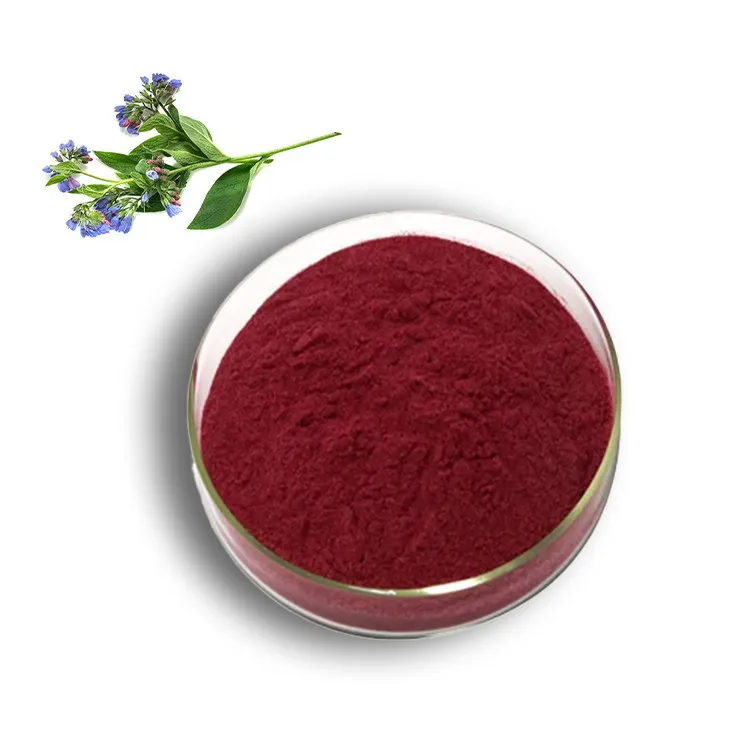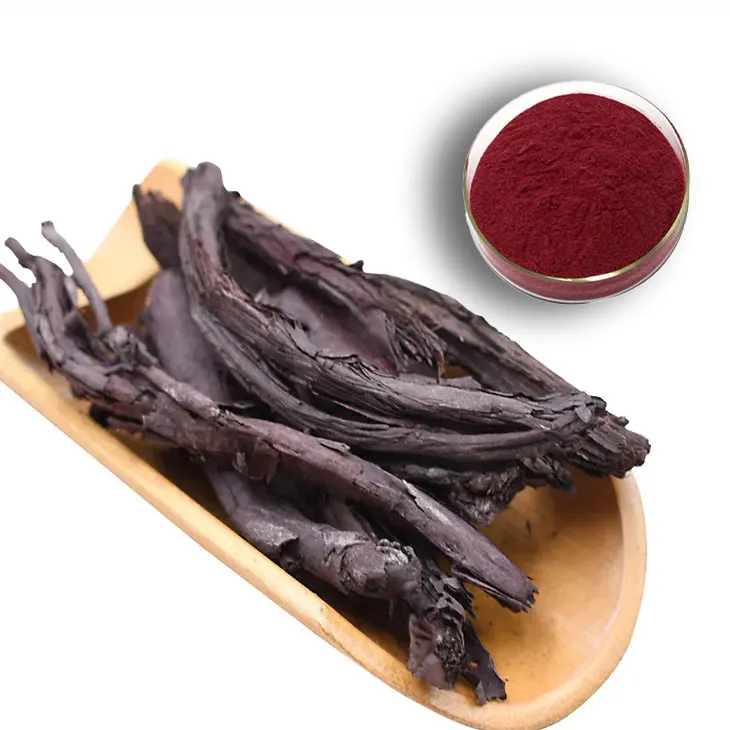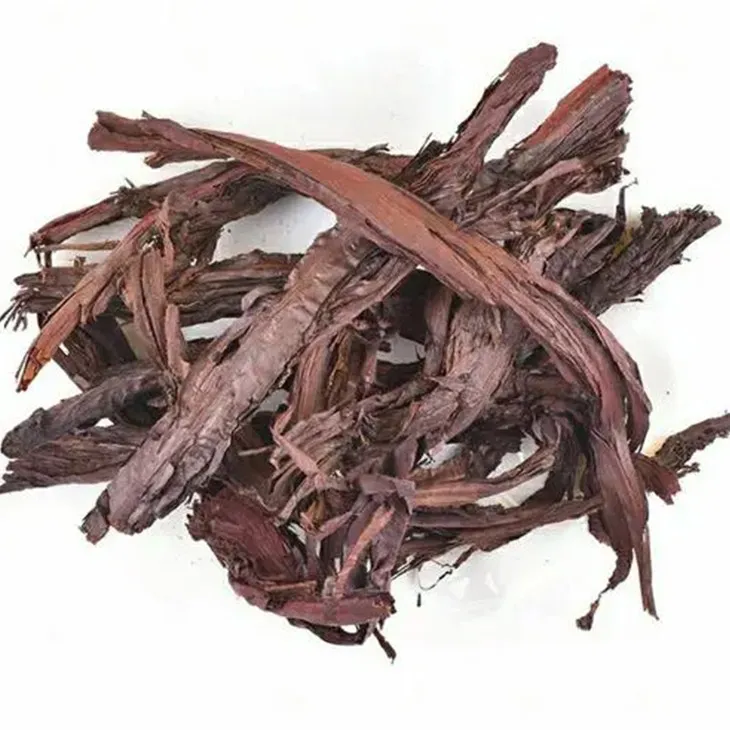- 0086-571-85302990
- sales@greenskybio.com
Five Efficacy of Shikonin + Dosage, Side Effects
2024-11-13

1. Introduction
Shikonin, a natural compound derived from the roots of the plant Lithospermum erythrorhizon, has been the focus of extensive research in recent years. Its diverse range of biological activities has made it a promising candidate for various therapeutic applications. In this article, we will explore in detail the five main efficacies of Shikonin, namely its anti - inflammatory, antioxidant, antimicrobial, anti - tumor, and wound - healing effects. Additionally, we will discuss the appropriate dosage and potential side effects associated with its use.

2. Anti - inflammatory Efficacy
2.1 Mechanism of Anti - inflammation
Shikonin exerts its anti - inflammatory effects through multiple pathways. One of the key mechanisms is its ability to inhibit the production of pro - inflammatory cytokines such as interleukin - 1β (IL - 1β), tumor necrosis factor - α (TNF - α), and interleukin - 6 (IL - 6). These cytokines play crucial roles in initiating and maintaining the inflammatory response. By suppressing their production, shikonin can effectively reduce inflammation at the cellular level.
Another important aspect of shikonin's anti - inflammatory action is its modulation of inflammatory signaling pathways. For example, it can interfere with the NF - κB (nuclear factor kappa - light - chain - enhancer of activated B cells) pathway. The NF - κB pathway is a central regulator of immune responses and inflammation. Shikonin can prevent the activation of NF - κB, thereby blocking the transcription of numerous genes involved in inflammation.
2.2 Evidence from Studies
Several in - vitro and in - vivo studies have demonstrated the anti - inflammatory efficacy of shikonin. In cell - based assays, treatment with shikonin has been shown to reduce the levels of inflammatory markers in macrophages and other immune cells. For instance, in a study using lipopolysaccharide (LPS) - stimulated macrophages, shikonin treatment significantly decreased the secretion of IL - 1β, TNF - α, and IL - 6.
In animal models of inflammation, such as the carrageenan - induced paw edema model in rats, shikonin has been proven to be effective in reducing swelling and inflammation. These findings suggest that shikonin has great potential as an anti - inflammatory agent for the treatment of various inflammatory diseases.

3. Antioxidant Efficacy
3.1 How Shikonin Acts as an Antioxidant
Shikonin functions as an antioxidant mainly by scavenging free radicals. Free radicals are highly reactive molecules that can cause oxidative damage to cells, including damage to DNA, proteins, and lipids. Shikonin has the ability to donate electrons to these free radicals, thereby neutralizing them and preventing oxidative damage.
Moreover, shikonin can also enhance the activity of antioxidant enzymes in the body. Antioxidant enzymes such as superoxide dismutase (SOD), catalase (CAT), and glutathione peroxidase (GSH - Px) play important roles in the body's antioxidant defense system. Shikonin can up - regulate the expression and activity of these enzymes, further strengthening the body's antioxidant capacity.
3.2 Importance in Preventing Oxidative Stress
Oxidative stress is associated with a wide range of diseases, including neurodegenerative diseases, cardiovascular diseases, and cancer. By acting as an antioxidant, shikonin can help prevent oxidative stress and potentially reduce the risk of these diseases. In neurodegenerative diseases like Alzheimer's and Parkinson's, oxidative damage to neurons is a key pathological feature. Shikonin's antioxidant properties may offer a protective effect on neurons, delaying the progression of these diseases.
In cardiovascular diseases, oxidative stress can lead to endothelial dysfunction, inflammation, and lipid peroxidation. Shikonin's antioxidant and anti - inflammatory effects may contribute to the protection of the cardiovascular system. Studies have shown that shikonin can reduce oxidative damage to the heart and blood vessels in animal models of cardiovascular diseases.

4. Antimicrobial Efficacy
4.1 Spectrum of Antimicrobial Activity
Shikonin exhibits broad - spectrum antimicrobial activity against a variety of microorganisms, including bacteria, fungi, and viruses. Against bacteria, it has been shown to be effective against both gram - positive and gram - negative bacteria. For example, it can inhibit the growth of Staphylococcus aureus, a common gram - positive pathogen, and Escherichia coli, a well - known gram - negative bacterium.
When it comes to fungi, shikonin has demonstrated antifungal activity against Candida albicans, a major fungal pathogen in humans. In addition, shikonin also shows some antiviral activity, although more research is needed to fully understand its mechanism against viruses.
4.2 Mechanisms of Antimicrobial Action
Shikonin's antimicrobial mechanisms are diverse. One of the main mechanisms is its disruption of the microbial cell membrane. It can insert into the lipid bilayer of the cell membrane, causing changes in membrane permeability. This leads to the leakage of intracellular components, ultimately resulting in cell death.
Another mechanism is its interference with microbial metabolic processes. Shikonin can inhibit certain enzymes or metabolic pathways in microorganisms, thereby preventing their growth and reproduction. For example, it has been reported to inhibit the synthesis of bacterial cell walls, which is essential for bacterial survival.
5. Anti - tumor Efficacy
5.1 Anti - tumor Mechanisms
Shikonin has multiple anti - tumor mechanisms. Firstly, it can induce apoptosis in cancer cells. Apoptosis is a programmed cell death process that is often dysregulated in cancer cells. Shikonin can activate apoptotic pathways in cancer cells, such as the caspase - mediated pathway. By triggering apoptosis, shikonin can effectively kill cancer cells without causing significant damage to normal cells.
Secondly, shikonin can inhibit tumor angiogenesis. Angiogenesis, the formation of new blood vessels, is crucial for tumor growth and metastasis. Shikonin can suppress the growth and function of endothelial cells involved in angiogenesis, thereby cutting off the blood supply to tumors and inhibiting their growth.
Furthermore, shikonin can also modulate the tumor microenvironment. It can affect the infiltration of immune cells into the tumor, as well as the cytokine profile in the microenvironment. By creating an unfavorable environment for tumor cells, shikonin can contribute to the inhibition of tumor growth.
5.2 Current Research and Clinical Trials
There is a growing body of research on the anti - tumor efficacy of shikonin. In pre - clinical studies, shikonin has shown promising results in various cancer models, including breast cancer, lung cancer, and melanoma. Some in - vitro studies have demonstrated that shikonin can significantly inhibit the growth and proliferation of cancer cells.
However, clinical trials are still in the early stages. A few small - scale clinical trials have been carried out to evaluate the safety and efficacy of shikonin in cancer patients. Although these trials have shown some positive signs, more extensive and large - scale clinical trials are needed to confirm its potential as an anti - tumor drug.
6. Wound - healing Efficacy
6.1 Role in Different Stages of Wound Healing
In the early stage of wound healing, shikonin can promote hemostasis. It can stimulate platelet aggregation and the release of platelet - derived growth factors, which are important for the initial clot formation and the recruitment of inflammatory cells to the wound site.
During the inflammatory phase of wound healing, shikonin's anti - inflammatory properties come into play. It can help regulate the inflammatory response, preventing excessive inflammation that may delay wound healing. In the proliferative phase, shikonin can stimulate the proliferation and migration of fibroblasts, which are responsible for the synthesis of extracellular matrix components such as collagen.
In the remodeling phase, shikonin can promote the maturation and organization of the newly formed extracellular matrix. It can also enhance the activity of matrix metalloproteinases (MMPs), which are involved in the remodeling of the extracellular matrix.
6.2 Clinical and Experimental Evidence
Animal studies have provided evidence for the wound - healing efficacy of shikonin. In a mouse model of cutaneous wounds, treatment with shikonin - containing ointments has been shown to accelerate wound closure compared to the control group. Some clinical studies on minor skin wounds have also suggested that shikonin - based preparations may have a beneficial effect on wound healing, although more comprehensive clinical trials are needed.
7. Dosage of Shikonin
7.1 Factors Affecting Dosage
The appropriate dosage of shikonin depends on several factors. The form of shikonin used, such as whether it is in the form of a pure compound, an extract, or a formulated product, can influence the dosage. For example, a highly purified shikonin may require a lower dosage compared to a crude extract.
The route of administration also plays a role in determining the dosage. Oral administration may require a different dosage compared to topical or intravenous administration. Additionally, the target disease or condition being treated affects the dosage. For anti - inflammatory applications, a different dosage may be needed compared to anti - tumor applications.
7.2 General Dosage Ranges
In general, for topical applications, shikonin - based ointments or creams may contain shikonin in a concentration range of 0.1% - 5%. For oral administration in some pre - clinical studies, dosages ranging from 10 - 100 mg/kg body weight have been used. However, it should be noted that these are only general ranges, and the optimal dosage should be determined based on individual patient factors and the specific application.
8. Side Effects of Shikonin
8.1 Common Side Effects
Although shikonin has many potential benefits, it may also cause some side effects. In some cases, topical application of shikonin - based products may cause skin irritation, such as redness, itching, or rash. This may be due to individual hypersensitivity to the compound or improper formulation of the product.
For oral administration, some individuals may experience gastrointestinal discomfort, including nausea, vomiting, or diarrhea. These side effects may be related to the dosage or the individual's tolerance to shikonin.
8.2 Safety Considerations
When using shikonin - based products, safety should be a top priority. Before starting any treatment with shikonin, it is important to consult a healthcare professional. They can assess the individual's health status, potential drug interactions, and determine the appropriate dosage and form of shikonin for the specific condition.
In addition, pregnant or breastfeeding women should be especially cautious when using shikonin - based products, as there is limited information on its safety in these populations. Long - term safety studies of shikonin are also needed to fully understand its potential risks.
9. Conclusion
Shikonin is a natural compound with remarkable five - fold efficacy, including anti - inflammatory, antioxidant, antimicrobial, anti - tumor, and wound - healing effects. Its diverse biological activities make it a valuable compound for further research and potential therapeutic applications. However, the dosage and potential side effects need to be carefully considered. Future research should focus on optimizing the dosage, conducting more extensive clinical trials, and further exploring its mechanisms of action to fully realize its potential in the field of medicine.
FAQ:
What are the anti - inflammatory mechanisms of shikonin?
Shikonin exerts its anti - inflammatory effects through multiple pathways. It can inhibit the production of pro - inflammatory cytokines such as interleukin - 1β (IL - 1β), interleukin - 6 (IL - 6) and tumor necrosis factor - α (TNF - α). Also, it can suppress the activation of nuclear factor - κB (NF - κB), which is a key transcription factor in the inflammatory response, thereby reducing the expression of many inflammatory - related genes.
How does shikonin play an antioxidant role?
Shikonin has antioxidant properties mainly because it can scavenge free radicals. Free radicals are highly reactive molecules that can cause oxidative damage to cells. Shikonin can directly react with free radicals such as superoxide anion radicals and hydroxyl radicals, converting them into more stable molecules, thus protecting cells from oxidative stress and reducing oxidative damage to biomolecules like DNA, proteins and lipids.
What types of microorganisms can shikonin inhibit?
Shikonin shows antimicrobial activity against a variety of microorganisms. It can inhibit the growth of bacteria, including both Gram - positive and Gram - negative bacteria. For example, it has been shown to be effective against Staphylococcus aureus and Escherichia coli. Additionally, shikonin also has antifungal activity against certain fungi species.
What are the possible anti - tumor mechanisms of shikonin?
There are several possible anti - tumor mechanisms of shikonin. It can induce apoptosis in tumor cells, which is a programmed cell death process. Shikonin can also interfere with the cell cycle of tumor cells, arresting them at certain phases and preventing their uncontrolled proliferation. Moreover, it may inhibit tumor angiogenesis, which is the process by which tumors develop a new blood supply to support their growth.
How is the dosage of shikonin determined in different applications?
The dosage of shikonin in different applications is determined by various factors. For example, in medicinal use, the dosage may be based on the type and severity of the disease, as well as the patient's age, body weight and overall health condition. In laboratory research, the dosage may be adjusted according to the experimental model and the purpose of the study. Generally, the appropriate dosage needs to be determined through pre - clinical and clinical trials or experimental optimization.
What are the common side effects of shikonin?
Some potential side effects of shikonin may include gastrointestinal discomfort such as nausea, vomiting or diarrhea. In some cases, allergic reactions may also occur, especially in individuals with hypersensitivity to shikonin or related compounds. However, the occurrence and severity of these side effects can vary depending on factors such as the dosage, the route of administration and the individual's susceptibility.
Related literature
- The Anti - Inflammatory Activity of Shikonin: A Review"
- "Antioxidant Properties of Shikonin and Its Therapeutic Implications"
- "Shikonin as an Antimicrobial Agent: Current Research and Future Perspectives"
- "Mechanisms of Shikonin in Anti - Tumor Therapy"
- "Dosage Considerations in Shikonin - Based Therapies"
- ▶ Hesperidin
- ▶ citrus bioflavonoids
- ▶ plant extract
- ▶ lycopene
- ▶ Diosmin
- ▶ Grape seed extract
- ▶ Sea buckthorn Juice Powder
- ▶ Beetroot powder
- ▶ Hops Extract
- ▶ Artichoke Extract
- ▶ Reishi mushroom extract
- ▶ Astaxanthin
- ▶ Green Tea Extract
- ▶ Curcumin Extract
- ▶ Horse Chestnut Extract
- ▶ Other Problems
- ▶ Boswellia Serrata Extract
- ▶ Resveratrol Extract
- ▶ Marigold Extract
- ▶ Grape Leaf Extract
- ▶ blog3
- ▶ blog4
- ▶ blog5
-
Organic Tongkat Ali extract powder factory.
2024-11-13
-
How to make powder with ashwagandha extract.
2024-11-13
-
Rosehip extract manufacturers from China.
2024-11-13
-
The best cat's claw extract in nature.
2024-11-13
-
Chinese Dandelion Leaf Extract Suppliers.
2024-11-13
-
Okra Extract
2024-11-13
-
Berberis aristata Extract
2024-11-13
-
Chasteberry Extract
2024-11-13
-
Black Garlic Extract
2024-11-13
-
Hops Extract
2024-11-13
-
Citrus Aurantii Extract
2024-11-13
-
Alisma Extract
2024-11-13
-
Hedyotis Diffusa Extract
2024-11-13
-
Yellow Pine Extract
2024-11-13
-
Hesperidin
2024-11-13





















